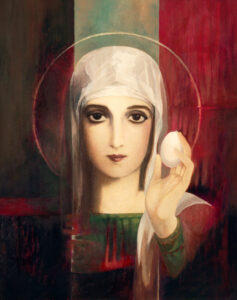St Mary Magdalene
Saint Mary Magdalene’s story is intimately linked with Jesus. She plays a leading role in one of the most powerful and important scenes in the Gospels. When Jesus was crucified, Mary of Magdala was there supporting him in his final moments and mourning his death. She discovered the empty tomb, and was the first witness to the resurrection. She was there at the beginning of a movement that was to transform the world.Mary Magdalene is mentioned in each of the four gospels in the New Testament. Mark and Luke speak of her being freed by Jesus from demonic possession, and thereafter supporting Jesus in his ministry, while all four gospels agree that Mary Magdalene was among the women who saw the crucifixion, and then in John we have the account of her witnessing the resurrection. Not once does it mention that she was a sinner.
The Eastern Orthodox tradition holds that from the moment Mary of Magdala was healed by Jesus (through the casting out of seven demons, cf. Luke. 8:2) she led a new life, and became a true disciple of Jesus, accompanying him on his ministry, betrayal, death and resurrection.
In recent years the view of Mary Magdalene in the Christian West has been transformed, and her true role in the story of salvation, as the first witness of the risen Christ, and the first to announce to the apostles the resurrection of the Lord, is now widely celebrated. In 2016, Pope Francis decreed that the Catholic Church’s yearly observance of St Mary Magdalene should be raised in rank to be equal to the feasts of the ApostlesMary Magdalene is representative of a Church which seeks to welcome, without distinction, women and men of every race, people, language and nation; to proclaim to them the good news of the Gospel of Jesus Christ; to accompany them on their earthly pilgrimage; and to offer them the wonders of God’s salvation. Mary Magdalene is an example of true and authentic evangelisation, that is, an evangeliser who proclaims the joyful central message of Easter.
The feast of St Mary Magdalene is celebrated on the 22nd July each year.
MARY MAGDALENE AND THE EASTER EGG
According to tradition, after Jesus’ Ascension into heaven, the Mag dalene—a wealthy woman of some importance—boldly presented herself to the Emperor Tiberius Caesar in Rome to proclaim the resurrection of Jesus Christ, with an egg in hand to illustrate her message.
dalene—a wealthy woman of some importance—boldly presented herself to the Emperor Tiberius Caesar in Rome to proclaim the resurrection of Jesus Christ, with an egg in hand to illustrate her message.
 dalene—a wealthy woman of some importance—boldly presented herself to the Emperor Tiberius Caesar in Rome to proclaim the resurrection of Jesus Christ, with an egg in hand to illustrate her message.
dalene—a wealthy woman of some importance—boldly presented herself to the Emperor Tiberius Caesar in Rome to proclaim the resurrection of Jesus Christ, with an egg in hand to illustrate her message.Holding the egg out to him, she exclaimed for the first time what is now the universal Easter proclamation among Christians, “Christ is risen!”
The emperor, mocking her, said that Jesus had no more risen than the egg in her hand was red. Immediately, the egg turned red as a sign from God to illustrate the truth of her message. The Emperor then heeded her complaints about Pilate condemning an innocent man to death, and had Pilate removed from Jerusalem under imperial displeasure.
In some iconography we read St Mary Magdalene holding an egg (usually red in colour). Why would Mary Magdalene bring an egg to talk about Jesus with the Roman Emperor?
Our image of St Mary Magdalene by the artist Richard Stodart, could be used for reflection and prayer with the words; ‘He is Risen’ or ‘I believe; help my unbelief’ from Mark 9:24.
Image of St Mary Magdalene by Richard Stodart is used with permission.
THE EASTER EGG TRADITION
For many cultures, even before the time of Christianity, the egg was a symbol of creation, spring, and rebirth. After the resurrection of Christ, the egg took on a new meaning for Christians and became a symbol of new life breaking forth while leaving the empty tomb behind. Perhaps this became even more pronounced due the account of Mary Magdalene.
Eggs were what helped people to understand a new theological truth – the resurrection of the dead, and a new religion – Christianity – built around the first Resurrection.
As a symbol of Christ’s resurrection, the Easter egg then became a symbol for the rebirth of all humanity due to the merits of Jesus Christ. “Easter eggs” were shared with one another as a joyful symbol of Christian hope.

